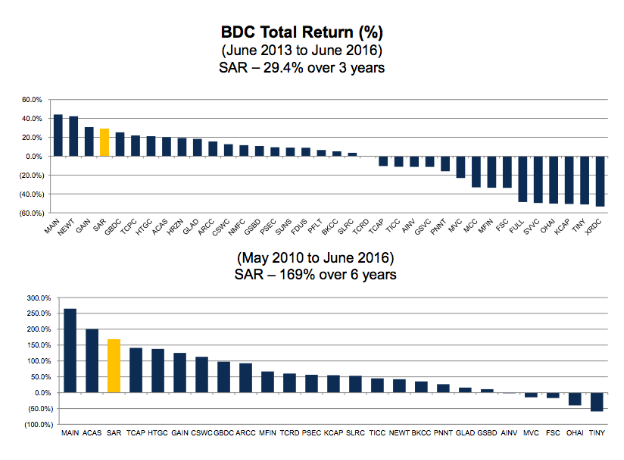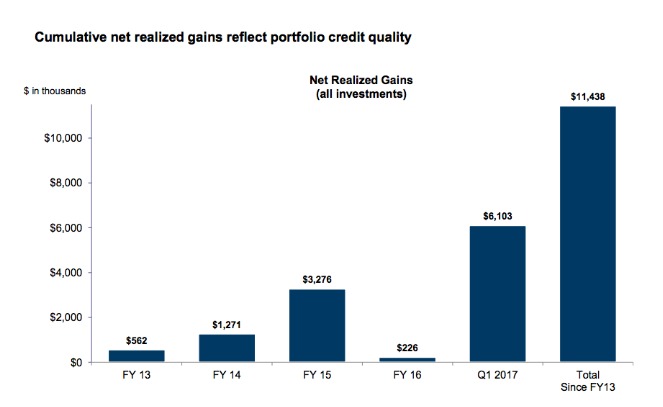So, you’ve decided that investing in BDCs is the right move for you. You know how they stack up against traditional investments; you’ve asked all the necessary questions to choose BDCs that best fit your profile. Once you understand the ins and outs of BDCs, their history and their benefits, your next question is likely: how do I select the right portfolio?
The answer to this question is not a simple one, as everyone has different needs and BDCs are known for their complexity. But there are some key steps you should remember to take when choosing a portfolio. I hope that these will guide you in your decision, and help make the most of your BDC investments.
1. Analyze BDCs for total return
When selecting a BDC portfolio, you really need to do your homework. That means analyzing BDCs to determine if they are worthwhile.
What a lot of people don’t realize about analyzing BDCs is that you can’t judge a BDC on stock value alone. Instead, you have to analyze stock price plus the dividend, something called “total return.”
The reason? Because BDCs are registered investment corporations, they are required to pay out 90 percent of earnings every year, so looking at a stock price over time only tells a small part of the story. It doesn’t capture, for instance, all of the dividends that have been paid, without which the total return is a mystery.
You’ll need to combine the dividends with stock prices to get this amount. When you understand the amount being paid regularly to shareholders, you’ll get a more accurate depiction of the stock’s performance, and what it would mean as part of your portfolio. With this information, you will see how compelling the top BDCs are as investments.
See below for BDCs evaluated for total return. Our company, Saratoga Investment Corp., is highlighted in yellow:
2. Look at the historical performance
One of the best ways to predict how a BDC will work for you in the future is to look at its historical performance, or even better, the historical performance of an entire portfolio. Though past performance should not be looked at as a sure-fire indicator of what’s to come, it can give you insight into trends and potential volatility.
If you want a BDC portfolio that is diverse and includes companies with good margins and return on assets, a snapshot is not enough. If realized gains and losses are available for scrutiny, they can be a great indicator of how accurate the unrealized gains are. (Realized gains can also determine credit quality, which I’ll get to in a moment.)
Another tip: Generally, if you see interest rates are going up over time, it means that the economy is doing well. On the other hand, it means borrowers are paying more, so while new loans are promising there is always the possibility of default for existing portfolio companies.
3. Determine the credit quality
If you want to invest in a low-risk BDC, it’s essential that you analyze a BDC portfolio’s credit quality first. The average portfolio yield and asset class can help you evaluate credit quality, as can realized gains over time.
It can be difficult to get an accurate rating on credit quality from unrealized gains, so as an investor you need to look at the companies a BDC is investing in to trust that they are good loans generating a steady cash flow.
Our company Saratoga offers a representative sample of the companies we invest in so that investors know the industries and specific businesses we help fund. More specific information can be found in our SEC filings, and we update our overview regularly to include new investments.
When selecting a BDC portfolio, these are all elements to look for. Diversity, industry, structure, securities, and investment size will all help indicate portfolio quality, as will outsider ratings and opinions.
4. Take advantage of transparency
When you invest in a BDC, you aren’t just investing in a simple stock, but everything beneath it. If you are willing to do your homework you can dissect an entire portfolio from top to bottom. This way, you can see exactly what you’re getting.
It can still be difficult to analyze: you’re given all of the information need, but you may not know much about the companies because they are small to mid-sized, without public financial records. Still, smart research can help you evaluate what’s in a BDC portfolio and how will it will perform. Look for which industries a BDC portfolio is invested in — if it’s an industry that’s thriving, you’ll be in good shape. But if it’s a struggling industry, they might default on their loans.
For example, Saratoga has investments in healthcare, business services, consumer services, among others, industries that are generally safe and on the up. Industries that you might want to have avoided? Oil and gas, for starters.
Below is a breakdown of Saratoga’s investments. It’s charts like this you should look for when making BDC investment decisions.
5. Understand the importance of management and their alignment with investors
Management can make or break the credibility and performance of a BDC portfolio. After all, management teams are the ones deciding which companies to invest in and determining valuation — a job which requires much analysis. Good management should have years of experience, professionalism, and a proven track record. You’ll also want to make sure management isn’t overly aggressive on portfolio growth to generate more short-term profit. Earning transcripts can tip you off to this kind of internal inflation.
The most important indicator of alignment of management with shareholders is management ownership of their BDC stock. Our company, Saratoga, at 24% management ownership, has one of the highest ownership levels in the industry.
6. Remember, you can always diversify your diversifications
Saratoga’s portfolio is incredibly diverse, and our management has 25 years experience investing in mid-market companies: about the entire timespan BDCs have existed. But even if you think Saratoga suits your needs, you as an investor can go beyond by seeking out other BDCs to strengthen your diversification. This mitigates risk and makes your own portfolio more robust.
All things considered, the right BDC portfolio is one that you are confident in because you’ve done your research and are impressed by management, total return, past performance, and all of the little details other investors overlook. Once you’ve done your due diligence, it should be clear what the right choice is for you.






